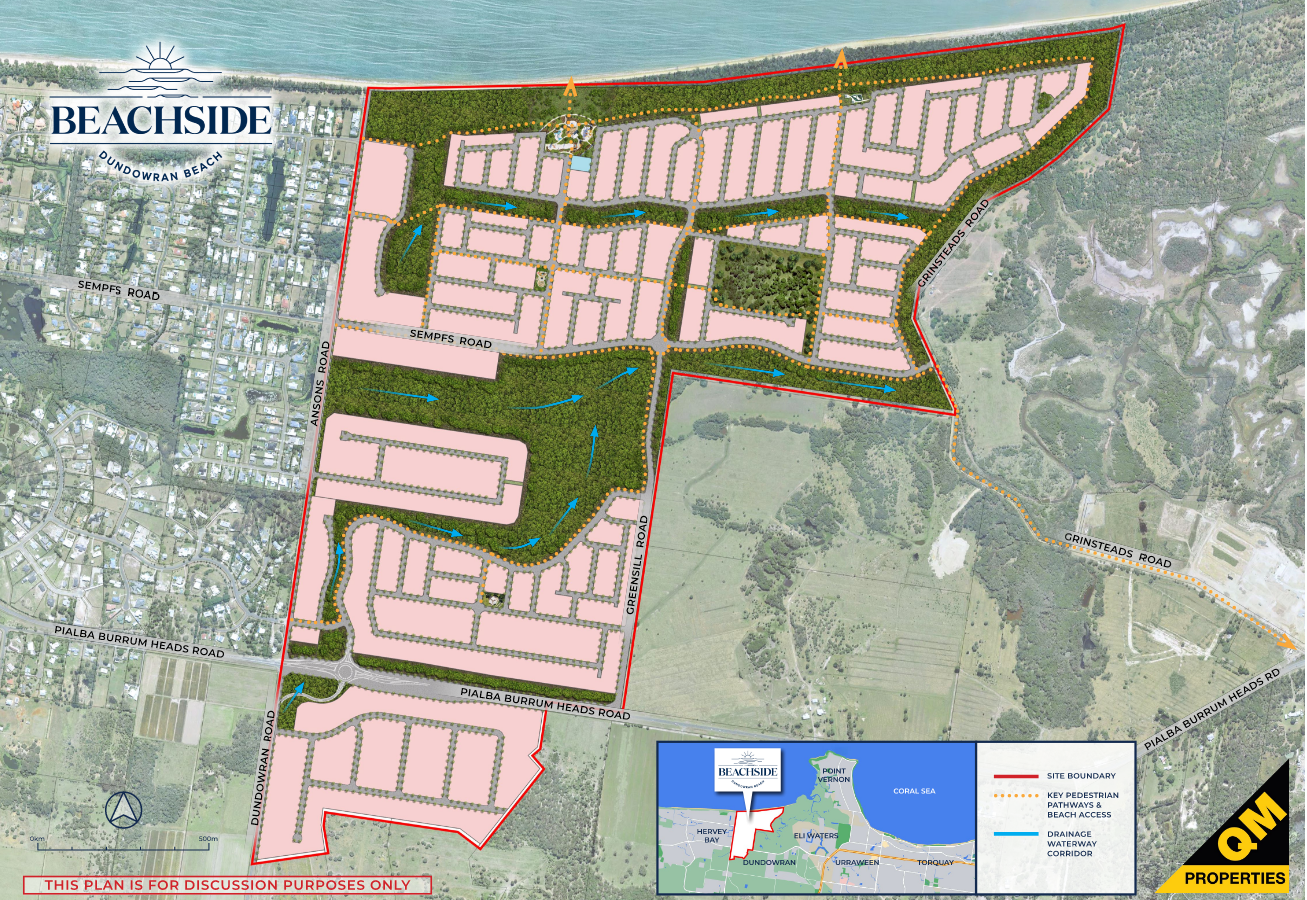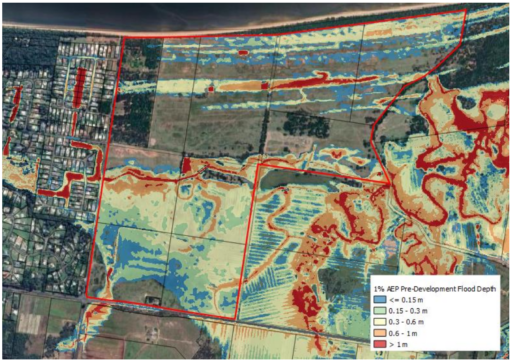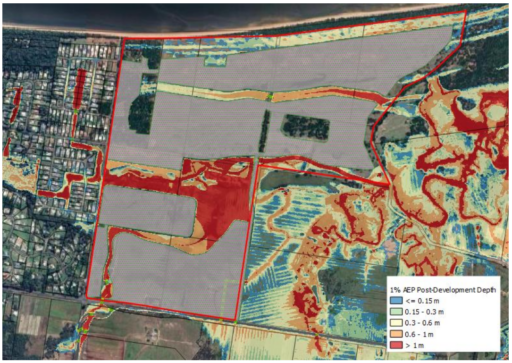Beachside Benefits from a Masterful Planning Approach

Situated fronting Dundowran Beach in Hervey Bay, the Beachside development is a 250-hectare master planned community set to contain over 1,500 residential lots, with QM Properties delivering the community over 50 stages.
Initially involved in reviewing existing development plans following the purchase of the site by QM, Inertia’s scope quickly grew as we worked collaboratively with our client to maximise available lots, create a complete stormwater and flood plan, support the development application approval process and community engagement strategies.
Ryan Llewelyn is Inertia’s project lead, and we caught up with him to discuss the project, its challenges and how a collaborative approach can make all the difference when designing and developing master-planned communities.
“Beachside is one of the most significant property developments happening on the Fraser Coast, and it is exciting to be part of delivering a master-planned community that will be seen as a benchmark for future developments.”
“Our involvement started when QM acquired the site and wanted to revisit the existing plans to look at whether they were the best solution for the site and its future residents. At the time, the site didn’t have an approved master flood or stormwater plan, meaning that a lot of the available land was deemed unusable, impacting the potential financial performance of the site.”
“The concept for the development was largely stalled at this stage, in a low-lying coastal location, there was zero likelihood of the development progressing without a clear stormwater and flood strategy, so our civil team got to work and, treating the site like a blank page, identified opportunities to make the site usable and increase the available development space.”
“We always like to push ourselves and to challenge what was planned, not just accept what was originally proposed. Having an integrated flood and civil team meant that we could take multiple perspectives and experiences to challenge convention and to offer alternative solutions.”
Supporting Ryan was Lead Civil Designer Benjamin Moyle, and between them, they set clear internal goals and mapped out strategies to deliver them and maximise the opportunity for the client.
“We had five main goals when delivering the project for QM Properties, each of which was set in partnership with the client, so we shared ownership of each, fostering stronger collaboration and openness to share ideas and have honest conversations. It’s an approach that helps us to be fully embedded in a project and works well, particularly for projects that will be delivered over multiple stages and years.”
The team’s goals were:
- Understand the project site, its limitations and opportunities
- Maximise available development land
- Deliver affordable flood and water management solutions
- Connect and collaborate with stakeholders
- Ensure approvals are obtained
Early collaboration with the council, understanding their unique challenges, and tailoring a water-sensitive urban design (WSUD) bespoke solution specific to the Beachside project allowed the project team to eliminate the need for large, space-consuming water treatment measures while still addressing water quality concerns. By going back to a first principles approach to WSUD and aligning the solution with the council’s priorities, the project team crafted a system that mitigated the need for extensive end-of-line treatments, such as bio basins and GPTs. The significance of this innovation goes beyond just efficient land use; it translates into a substantial reduction in ongoing maintenance costs for the council, which is a relief from the challenges of maintaining water quality devices in a saltwater environment. This not only improved the project’s efficiency but also maintained positive relationships with the council, which is essential in the successful completion of such developments.
Results
Not only did our team successfully optimise land use and address water quality concerns but we were able to address external flooding impacts which were unresolved in the initial scheme. The team’s strategic approach delivered a fully integrated flood model and stormwater strategy, which removed the need to invest in overengineered stormwater management devices. At the same time, we created networks with stakeholders to support and collaborate on the approval process, which resulted in approvals being received in a short timeframe, less than 12 months from our appointment.
By taking this approach, the team was able to increase available development land by 25,000m2. This equates to approximately 50 additional lots, a significant improvement on the originally proposed concept.
Guide For Success
“Based on our experience, we’ve taken several learnings from past projects and applied them to Beachside with great success, an approach which we can build on and repeat across all master-planned projects. The results speak for themselves; Beachside has a long-term plan, approvals from the council and associated entities such as the Department of Transport and Main Roads, and we have a reputation for being consultative and collaborative to ensure the best possible outcome. We are also heavily involved in industry networks in the region, being active members of the UDIA Fraser Coast Branch Committee, enabling us to build strong relationships, understand localised issues and help advocate for and support moves for positive development,” said Ryan.
The rules to follow are:
- Challenge – Explore, uncover and get immersed in the project and be prepared to challenge existing plans to offer alternative solutions.
- Early Collaboration – Get stakeholders involved as early as possible in the project. This makes approvals far easier; it helps understand nuances between regions and approving entities and provides a stronger, more collaborative relationship.
- Know your goals – Set clear goals and objectives for your internal team and align them with the goals of the client so that shared goals are the driving force behind the project.
- Work with your stakeholders – stakeholders are not your enemy, so don’t treat them as such; get involved, talk to people, work with and ask questions of government and councils and be open and honest.
- Be present – We’ve spent a lot of time in and around Beachside, attending events, joining networks, building relationships, answering questions and consulting. Projects matter to the people and organisations they will share a home with, so be present and be part of the community you are working with.
- Get to site – Models are great, satellite maps are awesome, but there is nothing better than being on-site, getting immersed in the location and giving your team context. On a project like Beachside, being on-site regularly, and understanding the geography, topography, location, waterways, and more was invaluable when creating the masterplan, as our entire team had a thorough understanding of the site, its limitations and opportunities.
As Beachside’s masterplan rolls out over the next decade, we will keep you up to date on the development’s progress. In the meantime, check out the master-planned communities we have supported here: Land Subdivisions Archives – Inertia Engineering : Inertia Engineering or contact us to discuss how we can get a stalled project back on track or assist with the seamless design and delivery of your next community.
 Back to News
Back to News


